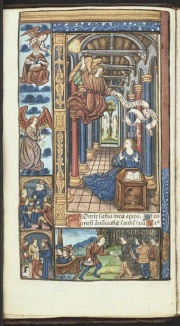Vellum
Description
A fine, white translucent writing material made from untanned Calfskin that is dried under tension. Vellum is made by cleaning, dehairing, scraping and stretching the skin until a smooth, thin semitransparent page is obtained. The final smoothing step involves polishing with Pumice or Talc to create a uniform writing surface. Vellum was made by the Hebrews over 3000 years ago. Medieval manuscripts were made from slunk skins from unborn and stillborn animals. In the 16th century and later, vellum was also occasionally used for etchings and engravings as well as for book bindings. Today, the word 'vellum' is sometimes used interchangeably with Parchment and generally refers to smooth, ungrained skins made from small animals. In addition to writing paper, vellum is used for banjos, drumheads, and lamp shades.
Synonyms and Related Terms
velijn (Ned.); velin (Fr.); Pergament (Deut.); Schriebpergament (Deut.); pergamena (It.); vitela (Esp.); velino (Port.); pergamino (Esp.); veläng (Sven.); finaste pergament (Sven.)
Additional Images
Resources and Citations
- R. J. Gettens, G.L. Stout, Painting Materials, A Short Encyclopaedia, Dover Publications, New York, 1966
- G.S.Brady, Materials Handbook, McGraw-Hill Book Co., New York, 1971 Comment: p. 582
- Ralph Mayer, A Dictionary of Art Terms and Techniques, Harper and Row Publishers, New York, 1969 (also 1945 printing)
- Hermann Kuhn, Conservation and Restoration of Works of Art and Antiquities, Butterworths, London, 1986
- Matt Roberts, Don Etherington, Bookbinding and the Conservation of Books: a Dictionary of Descriptive Terminology, U.S. Government Printing Office, Washington DC, 1982
- Book and Paper Group, Paper Conservation Catalog, AIC, 1984, 1989
- Silvie Turner, Which Paper?, Design Press, New York, 1991
- Multilingual Glossary for Art Librarians at http://www.ifla.org/VII/s30/pub/mgl.htm



